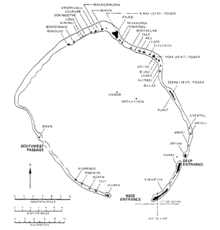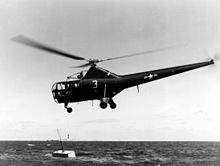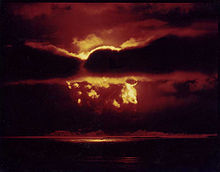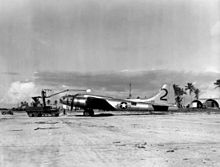- Operation Sandstone
-
Operation Sandstone 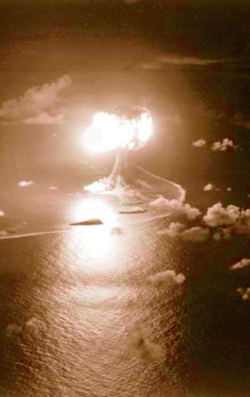
Sandstone X-RayInformation Country United States Test site Pacific Proving Grounds Period April – May 1948 Number of tests 3 Test type Atmospheric tests Device type Fission Max. yield 49 kilotons of TNT (210 TJ) Navigation Previous test Operation Crossroads Next test Operation Ranger Operation Sandstone was a series of nuclear weapon tests in 1948. It was the third series of American tests, following Crossroads and preceding Ranger. Like the Crossroads tests, the Sandstone tests were carried at the Pacific Proving Grounds, although at Enewetak Atoll rather than Bikini Atoll, but differed from Crossroads in that they were primarily conducted by the Atomic Energy Commission, with the armed forces having only a supporting role. The purpose of the Sandstone tests was also different, in that they were primarily tests of new bomb designs rather than the effects of nuclear weapons.
As was the custom, each detonation was given its own code name:
Sandstone Test Blasts Test name Date Location Yield X-Ray 14 April 1948 Engebi Island 37 kilotons Yoke 30 April 1948 Aomon Island 49 kilotons Zebra 14 May 1948 Runit Island 18 kilotons Contents
Origins
Nuclear weapons were developed during World War II by the Manhattan Project, which created a network of production facilities, and the weapons research and design laboratory at the Los Alamos National Laboratory.[1] Two types of bombs were developed: the Mark I Little Boy, a gun-type fission weapon using uranium-235, and the Mark III Fat Man, an implosion-type nuclear weapon using plutonium.[2]
These weapons were not far removed from their laboratory origins. A great deal of work remained to improve ease of assembly, safety, reliability and storage before they were ready for production. There were also many improvements to their performance that had been suggested or recommended during the war that had not been possible under the pressure of wartime development. Norris Bradbury, who replaced Robert Oppenheimer as director at Los Alamos, felt that "we had, to put it bluntly, lousy bombs."[3]
Plutonium was produced by irradiating uranium-238 in three 250 MW nuclear reactors at the Hanford site. In theory they could produce 0.91 grams (0.032 oz) of plutonium per megawatt-day, or about 20 kilograms (44 lb) per month. In practice, production never approached such a level in 1945, when only between 4 and 6 kilograms (8.8 and 13 lb) was produced per month. A Fat Man core required about 6.2 kilograms (14 lb) of plutonium, of which 21% fissioned. Plutonium production fell off during 1946 due to swelling of the reactors' graphite neutron moderators. This is known as the Wigner effect, after its discoverer, the Manhattan Project scientist Eugene Wigner.[4]
These reactors were also required for the production of polonium-210 by irradiation of bismuth-209, which was used in the modulated neutron initiators, a critical component of the nuclear weapons. Some 62 kilograms (140 lb) of bismuth-209 had to be irradiated for 100 days to produce 600 curies of polonium-210, a little over over 132 milligrams (2.04 gr). Because polonium-210 has a half-life of only 138 days, at least one reactor had to be kept running. The oldest unit, B pile, was therefore closed down so that it would be available in the future. Investigation of the problem would take most of 1946 before a fix was found.[5]
Uranium-235 was produced from enrichment of natural uranium at the Oak Ridge National Laboratory. Improvements in the processes and procedures of the electromagnetic and gaseous isotope separation between October 1945 and June 1946 led to an increase in production to around 69 kilograms (150 lb) of uranium-235 per month, which was only enough for one of the very wasteful Little Boys. A Fat Man was 17.5 times as efficient as a Little Boy, but a ton of uranium ore could yield eight times as much uranium-235 as plutonium, and on a per-gram basis, plutonium cost somewhere between four and eight times as much to produce as uranium-235,[6] which at this time cost around $26 per gram.[7]
Weapon development 1945–48
See also: nuclear weapon designThe objectives of the Sandstone series of tests were to:
- test nuclear cores and initiators;
- improve the theory and knowledge of implosion type weapons;
- test levitated cores;
- test composite cores; and
- determine the most economic designs in terms of efficient use of fissionable material.[8]
Levitation meant that instead of being immediately inside the tamper, there would be an air gap between the tamper and the core, which would be suspended inside on wires. This would allow the tamper to gain more momentum before striking the core. The principle was similar to swinging a hammer at a nail. In order for this to work outside the laboratory, the wires had to be strong enough to withstand being dropped from an aircraft, but thin enough to not disturb the spherical symmetry of the implosion.[9] The Theoretical Division at Los Alamos, known as T Division, had run computer calculations on the levitated core as early March 1945.[10] The use of the levitated core had been proposed during the planning for Operation Crossroads, but it had been decided instead to use the existing solid core "Christy" design.[11] This was was named after its designer, Robert Christy.[12] For Sandstone, however, it was decided that at least two of the three tests would use levitated cores.[8]
The motivation behind the composite core was to make better use of the available fissionable material. The use of uranium-235 in an implosion weapon instead of the inefficient gun type Little Boy was an obvious development. However, while plutonium was more expensive and harder to produce than uranium-235, it fissions faster, because it makes better use of the neutrons its fission produces. On the other hand, the slower reaction of uranium-235 permits the assembly of super-critical masses, making it theoretically possible to produce weapons with high yields.[13] By July 1945, Oppenheimer and Groves were considering using both materials in a composite core containing 3.25 kilograms (7.2 lb) of plutonium and 6.5 kilograms (14 lb) of uranium-235. The composite cores became available in 1946. Los Alamos' priority then became the development of an all-uranium-235 core.[14] By January 1948 the national stockpile contained 50 cores, of which 36 were composite Christy cores, nine were plutonium Christy cores, and five were composite levitated cores.[15] Testing the levitated core, composite core and uranium-235 would require at least three test firings.[14]
More efficient weapons would require less efficient initiators. This meant that less polonium would be required. At the time of Sandstone, the national stockpile of polonium-beryllium initiators consisted of 50 A Class initiators, with more than 25 curies of polonium, and 13 B Class initiators with 12 to 25 curies. During Sandstone, at least one test would be conducted with a B Class initiator.[16]
Preparations
Organization
 Briefing on the USS Mount McKinley. Pictured are Colonel T. J. Sands, Captain James S. Russell, Dr. D. K. Froman, Brigadier General David A. Ogden, Major General J. D. Barker, Major General W. E. Kepner, Lieutenant General John E. Hull, Rear Admiral William S. Parsons, Rear Admiral Francis C. Denebrink, and Brigadier General Claude B. Ferenbaugh.
Briefing on the USS Mount McKinley. Pictured are Colonel T. J. Sands, Captain James S. Russell, Dr. D. K. Froman, Brigadier General David A. Ogden, Major General J. D. Barker, Major General W. E. Kepner, Lieutenant General John E. Hull, Rear Admiral William S. Parsons, Rear Admiral Francis C. Denebrink, and Brigadier General Claude B. Ferenbaugh.
The tests were authorized by President Harry S. Truman on 27 June 1947. The Atomic Energy Commission's Director of Military Applications, Brigadier General James McCormack and his deputy, Captain James S. Russell, met with Bradbury and John Manley at Los Alamos on 9 July to make arrangements for the tests. They readily agreed that they would be scientific in nature, with Los Alamos supplying the technical direction and the armed forces providing supplies and logistical support. The cost of the tests, around $20 million, was divided between the Department of Defense and the Atomic Energy Commission. Lieutenant General John E. Hull was designated as test commander.[17] Rear Admiral William S. Parsons and Major General William E. Kepner reprised their Operation Crossroads roles as deputy commanders.[18] Joint Task Force 7, was formally activated on 18 October 1947. As its Commander, Hull was answerable to both the Joint Chiefs of Staff and the Atomic Energy Commission.[19]
Joint Task Force 7 consisted of 10,366 personnel, of who 9,890 were military.[20] Its headquarters consisted of about 175 men, of whom 96 were on board the USS Mount McKinley. The rest were accommodated on the USS Albemarle, Curtiss and Bairoko.[21] A special division of the Los Alamos National Laboratory, known as J Division, was created specifically to manage nuclear testing. An Atomic Energy Commission group (Task Group 7.1) was responsible for preparing and detonating the nuclear weapons, and conducting the experiments. It consisted of some 283 scientists and technicians division responsible for nuclear tests from J Division, the Armed Forces Special Weapons Project, Naval Research Laboratory, Naval Ordnance Laboratory, Argonne National Laboratory, Edgerton, Germeshausen & Grier, the Aberdeen Proving Ground, Atomic Energy Commission, and other agencies. [21]
Each dealt with a different aspect of the tests. The Naval Ordnance Laboratory handled the blast measurement tests, while the Naval Research Laboratory conducted the radiation measurement experiments, and the Argonne National Laboratory did gamma ray measurements. Edgerton, Germeshausen & Grier were contractors hired contracted to design and install the timing and firing systems.[21] Seven experimental weapon assemblies and six cores were delivered to San Pedro, California, and loaded on USS Curtiss, the weapon assembly ship in February 1948. However, the Atomic Energy Commission only gave permission for the expenditure of three cores in the tests.[22]
Ships
The Naval forces were organized as Task Group 7.3. It consisted of:
- Task Unit 7.3.1
- USS Mount McKinley (flagship)
- Task Unit 7.3.2 Main Naval Task Unit
- USS Pickaway
- USS Warrick
- USS Curtiss
- USS Yancey
- USS Albemarle
- USS LST-45
- USS LST-219
- USS Crook County
- Task Unit 7.3.3 Offshore Patrol
- Task Unit 7.3.4 Helicopter Unit
- USS Bairoko – 4 HO3S and 2 HTL helicopters
- Task Unit 7.3.5 Services Unit
- USS Arequipa
- USS Pasig
- USS YOG-64
- USS YW-94
- Task Unit 7.3.6 Cable Unit
- USS LSM-250
- USS LSM-378
- Naval Signal Unit No. 1
- Task Unit 7.3.7 Boat Pool Unit
- USS Comstock
- USS Askari
- USS LCI-549
- USS LCI(L)-1054
- USS LCI(L)-1090
- USS LCI 472
- USS LCI-494
- USS LCI-l194
- USS LCI-1345
Source: Berkhouse et al, Operation Sandstone, p. 40
Civil affairs
In September 1947, Hull, Russell, who was designated test director on 14 October, and Joint Task Force 7's scientific director, Darol K. Froman from the Los Alamos Laboratories, set out out with a group of scientists and military officers to examine various proposed test sites in the Pacific.[17] Enewetak Atoll was chosen as the test site on 11 October.[23] The island was remote, but with a good harbor and an airstrip. It also had ocean currents and trade winds that would carry fallout out to sea, an important consideration in view of what had happened at Bikini Atoll during Operation Crossroads.[17]
As the Trust Territory of the Pacific Islands was a United Nations trust territory administered by the United States, the United Nations Security Council was notified of the upcoming tests on 2 December. The atoll was inhabited by the dri-Enewetak, who lived on Aomon, and the dri-Enjebi, who lived Bijire. Their original homes had been on Enewetak and Enjebi, but they had been moved during the war to make way for military bases. The population, about 140 in number, had been temporarily relocated to Meck Island during Operation Crossroads. This time, Ujelang Atoll, an uninhabited atoll 124 nautical miles (230 km; 143 mi) southwest of Enewetak, was selected as a relocation site. A Naval Construction Battalion group arrived there on 22 November to build accommodation and amenities. The military authorities met with the local chiefs on 3 December, and they agreed to the relocation, which was carried out by USS King County by 20 December.[24] An LST and four C-54 aircraft were placed on standby to evacuate Ujelan in case it was affected by fallout affected, but were not required.[25]
Unlike the Crossroads tests, which were conducted in the media spotlight, the Sandstone tests were carried out with minimal publicity. On 15 April, there was still discussion in Washington about whether or not there should be any public announcement of the tests at all. Hull opposed making any announcement until after the series was completed, but the AEC commissioners felt that the news would leak out, and the United States would look secretive. It was therefore decided to make a last minute anouncement. There was no announcement of the purpose of the tests, and only cursory press releases. On 18 May, after the series was over, Hull held a press conference in Hawaii, but only permitted the media to quote from written statements.[26]
Construction
Enjebi, Aomon, and Runit Islands were cleared of vegetation and graded level to make it easier to install the required instrumentation, and a causeway was built between Aomon and Bijire so the instrument cables could be run from the test tower on Aomon to the control station on Bijire. The detonations were ordered so that later test areas would suffer minimal fallout from the earlier shots.[27] The Army component, Task Group 7.2, was responsible for construction work. It consisted of the 1220th Provisional Engineer Battalion, with the 1217th and 1218th Composite Service Platoons, the 18th Engineer Construction Company and 1219th Signal Service Platoon; Companies D and E of the 2nd Engineer Special Brigade's 532nd Engineer Boat and Shore Regiment; the 461st Transportation Amphibious Truck Company; 854th Transportation Port Company; 401st CIC Detachment; and the Naval Shore Base Detachment.[28]
Operations
Video of the tests
As in Operation Crossroads, each detonation was given its own code name, based upon the Joint Army/Navy Phonetic Alphabet. All used modified Mark III assemblies, and were detonated from a 200-foot (61 m) towers.[29] The timing of the detonations was a matter of compromise. The gamma ray measurement experiments required darkness, but the B-17 drones that would sample the clouds needed daylight to control them. As a compromise, the Sandstone detonations all took place shortly before dawn.[30]
The X-Ray nuclear device used a levitated composite core.[29] It was detonated on Enjebi just before sunrise at 06:17 on 15 April 1948,[31] with a yield of 37 kilotons.[32] The efficiency of utilization of the plutonium was about 35%; that of the uranium-235 was 25% or more. This was somewhat higher than Los Alamos' prediction.[29] Observers watching from ships in the lagoon saw a brilliant flash and felt the radiant heat. A condensation cloud 5 nautical miles (9.3 km; 5.8 mi) in diameter of quickly enveloped the fireball, which glowed within the cloud. It took 45 to 50 seconds for the thunderous roar of the explosion to reach the observers.[31]
About 20 minutes later, Bariko launched a helicopter to check on the cable winch was was to collect samples. It also lowered boats to test radioactivity levels in the lagoon. B-17 pilotless drone aircraft were flown through the clouds, and a drone light tank was used to recover soil samples from the crater. Unfortunately, it became bogged and had to be towed out ten days later.[33]
The Yoke nuclear device used a levitated all-uranium-235 core.[29] It was detonated on Aomon just before sunrise on 1 May 1948 at 06:09, a day late due to unfavorable winds.[34] The observers saw a similar flash and felt the same heat as the X-Ray blast, but the 6-nautical-mile (11 km; 6.9 mi) wide condensation cloud was larger, and the sound of the explosion more forceful. One observer likened it to the sound of "a paper bag which is forcefully burst in a small room".[34] They were correct: its yield of 49 kilotons made it the largest nuclear detonation up to that time,[32] but it was considered inefficient and wasteful of the fissile material.[29]
Zebra, the third test, and the last of the Sandstone series, was detonated on Runit just before sunrise at 06:04 on 15 May 1948.[35] This test was characterized by AEC Chairman David Lilienthal as the "hardest and most important" test of the three. By using one of the B class initiators, it demonstrated that these could still be used with confidence.[36] The observers perceived the flash and blast as similar to the previous two tests, but this time the base of the condensation cloud was at 2,000 feet (610 m), which gave the observers an unobstructed view of the fireball, which therefore appeared to be brighter and last longer than the other two.[35] Looks were deceiving: its levitated uranium-235 core produced a yield of 18 kilotons.[32]
The procedures used in the previous tests were repeated, but this time the winch cable snagged, and the test samples had to be retrieved by a jeep, exposing its crew to more radiation. The Los Alamos personnel assigned to remove the filters from the B-17 drones had apparently carried out the procedure on X-Ray and Yoke without problems, but this time three of them suffered radiation burns on their hands serious enough to be hospitalized and need skin grafting. One of the men who had carried out the procedure for Yoke was then also found to have burns on his hands and was hospitalized too, but was discharged on 28 May. Once again the drone tank gave trouble, and bogged in the crater, but the soil samples were retrieved by the backup drone tank. Both tanks were subsequently dumped in the ocean.[37]
Outcome
The successful testing of the new cores in the Sandstone tests had a profound effect. Practically every component of the old weapons was rendered obsolete.[8] Even before the third test had been carried out, Bradbury had halted production of the old cores, and ordered that all effort was to be concentrated on the Mark 4, which would become the first mass-produced nuclear weapon.[38] The more efficient use of fissionable material would increase the nuclear stockpile from 56 bombs in June 1948 to 169 in June 1949.[39] The Mark III bombs would be withdrawn from service in 1950.[40] At the same time, new production plants were coming online, and the Wigner disease problem had been solved. By May 1951, plutonium production twelve times that of 1947, while uranium-235 production had increased eight-fold.[41] The Chief of the Armed Forces Special Weapons Project, Major General Kenneth D. Nichols, saw clearly that the era of scarcity was over. He now "recommended that we should be thinking in terms of thousands of weapons rather than hundreds."[42]
Notes
- ^ Brahmstedt 2002, pp. 2–8.
- ^ Hansen 1995, pp. 82–83.
- ^ Rhodes 1995, pp. 212–213.
- ^ Hansen 1995, pp. 83, 208–213.
- ^ Hansen 1995, pp. 213–215.
- ^ Hansen 1995, pp. 83, 212.
- ^ Hansen 1995, p. 264.
- ^ a b c Hansen 1995, p. 205.
- ^ Rhodes 1995, pp. 188–189.
- ^ Fitzpatrick 1999, p. 94.
- ^ Hansen 1995, p. 203.
- ^ Hansen 1995, p. 126.
- ^ Hansen 1995, p. 207.
- ^ a b Hansen 1995, pp. 224–227.
- ^ Hansen 1995, p. 240.
- ^ Hansen 1995, pp. 216, 240, 245.
- ^ a b c Hewlett & Duncan 1962, pp. 139–141.
- ^ Christman 1998, pp. 234–239.
- ^ Berkhouse et al. 1983, p. 30.
- ^ Berkhouse et al. 1983, p. 1.
- ^ a b c Berkhouse et al. 1983, pp. 30–35.
- ^ Hansen 1995, pp. 240–241.
- ^ Berkhouse et al. 1983, p. 18.
- ^ Berkhouse et al. 1983, pp. 18–21.
- ^ Berkhouse et al. 1983, p. 103.
- ^ Hewlett & Duncan 1962, pp. 163–164.
- ^ Berkhouse et al. 1983, p. 102.
- ^ Berkhouse et al. 1983, p. 38.
- ^ a b c d e Hansen 1995, pp. 242–245.
- ^ Berkhouse et al. 1983, p. 104.
- ^ a b Berkhouse et al. 1983, p. 105.
- ^ a b c Hewlett & Duncan 1962, p. 672.
- ^ Berkhouse et al. 1983, pp. 105–109.
- ^ a b Berkhouse et al. 1983, p. 110.
- ^ a b Berkhouse et al. 1983, p. 114.
- ^ Hansen 1995, p. 245.
- ^ Berkhouse et al. 1983, pp. 114–116.
- ^ Hewlett & Duncan 1962, pp. 175–176.
- ^ Hansen 1995, p. 149.
- ^ Hansen 1995, p. 229.
- ^ Hansen 1995, p. 255.
- ^ Nichols 1987, p. 269.
References
- Berkhouse, L. H.; Davis, S. E.; Gladeck, F.R.; Hallowell, J. H.; Jones, C. R.; Martin, E. J.; McMullan, F. W.; Osborn, M. J. et al. (1983). Operation Sandstone: 1948. Washington, D. C.: Defense Nuclear Agency. OCLC 10437826. http://www.dtic.mil/dtic/tr/fulltext/u2/a139151.pdf. Retrieved 17 August 2011.
- Brahmstedt, Christian (2002). Defense's Nuclear Agency, 1947–1997. DTRA history series. Washington, DC: Defense Threat Reduction Agency, US Department of Defense. OCLC 52137321. http://www.dtra.mil/documents/aboutdtra/DefensesNuclearAgency.pdf. Retrieved 1 August 2011.
- Christman, Albert B. (1998). Target Hiroshima: Deak Parsons and the Creation of the Atomic Bomb. Annapolis, Maryland: Naval Institute Press. ISBN 1557501203. OCLC 38257982.
- Fitzpatrick, Anne (1999). Igniting the Light Elements : The Los Alamos Thermonuclear Weapon Project, 1942-1952 (PhD thesis). Los Alamos, New Mexico: Los Alamos National Laboratory. OCLC 76786558. LA-13577-T. http://scholar.lib.vt.edu/theses/available/etd-121898-140317/. Retrieved 4 October 2011.
- Hansen, Chuck (1995). Volume I: The Development of US Nuclear Weapons. Swords of Armageddon: US Nuclear Weapons Development since 1945. Sunnyvale, California: Chukelea Publications. ISBN 978-0-9791915-1-0. OCLC 231585284.
- Hewlett, Richard G.; Duncan, Francis (1962). Atomic Shield, 1947–1952. A History of the United States Atomic Energy Commission. University Park, Pennsylvania: Pennsylvania State University Press. ISBN 0-520-07187-5. OCLC 3717478.
- Nichols, Kenneth David (1987). The Road to Trinity: A Personal Account of How America's Nuclear Policies Were Made. New York, New York: William Morrow and Company. ISBN 0-688-06910-X. OCLC 15223648.
- Rhodes, Richard (1995). Dark Sun: The Making of the Hydrogen Bomb. New York: Simon & Schuster. ISBN 0-684-80400-X. OCLC 32509950.
External links
Coordinates: 11°27′55″N 162°11′20″W / 11.46528°N 162.18889°W
Categories:- American nuclear explosive tests
- Enewetak Atoll
Wikimedia Foundation. 2010.

